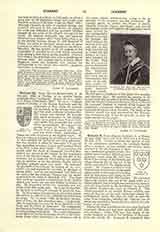

Clement X, POPE (EMILIO ALTIERI), b. at Rome, July 13, 1590; elected April 29, 1670, and d. at Rome, July 22, 1676. Unable to secure the election of any of the prominent candidates, the cardinals finally, after a conclave of four months and twenty days, resorted to the old expedient of electing a cardinal of advanced years; they united upon Cardinal Altieri, an octogenarian, whose long life had been spent in the service of the Church, and whom Clement IX, on the eve of his death, had raised to the dignity of the purple. The reason a prelate of such transcendent merits received the cardinalate so late in life seems to have been that he had waived his claims to the elevation in favor of an older brother. He protested vigorously against this use of the papal robes as a funeral shroud, but at length was persuaded to accept, and out of gratitude to his benefactor, by ten years his junior, assumed the name of Clement X. The Altieri belonged to the ancient Roman nobility, and since all but one of the male scions had chosen the ecclesiastical career, the pope, in order to save the name from extinction, adopted the Paoluzzi, one of whom was married to Laura Caterina Altieri, the sole heiress of the family.
During previous pontificates the new pope had held important offices and had been entrusted with delicate missions. Urban VIII gave him charge of the works designed to protect the territory of Ravenna from the unruly Po. Innocent X appointed him nuncio to Naples; and he is credited with no slight share in the reestablishment of peace after the stormy days of Masaniello. Under Alexander VII he was made secretary of the Congregation of Bishops and Regulars. Clement IX named him superintendent of the papal exchequer. On his accession to the papacy, he gave to his new kinsman, Cardinal Paoluzzi-Altieri, the uncle of Laura‘s husband, the office of cardinal nephew, and with advancing years gradually entrusted to him the management of affairs, to such an extent that the biting Romans said he had reserved to himself only the Episcopal functions of benedicere et sanctificare, resigning in favor of the cardinal the administrative duties of regere et gubernare. Nevertheless, the “Bullarium Romanum” contains many evidences of his religious activity, among which may be mentioned the canonization of
Sts. Cajetan, Philip Benitius, Francis Borgia, Louis Bertrand, and Rose of .Lima; also the beatification of Pope Pius V, John of the Cross, and the Martyrs of Gorcum in Holland.
He labored to preserve the peace of Europe, menaced by the ambition of Louis XIV, and began with that imperious monarch the long struggle concerning the regale, or revenues of vacant dioceses and abbeys. He supported the Poles with strong financial aid in their hard struggle with their Turkish invaders. He decorated the bridge of Sant’ Angelo with the ten statues of angels in Carrara marble still to be seen there. To Clement we owe the two beautiful fountains which adorn the Piazza of St. Peter’s. At a cost of 300,000 scudi (dollars) he erected the extensive Palazzo Altieri. His remains lie in St. Peter’s church near the tribune, where a monument has been erected to his memory.
JAMES F. LOUGHLIN

